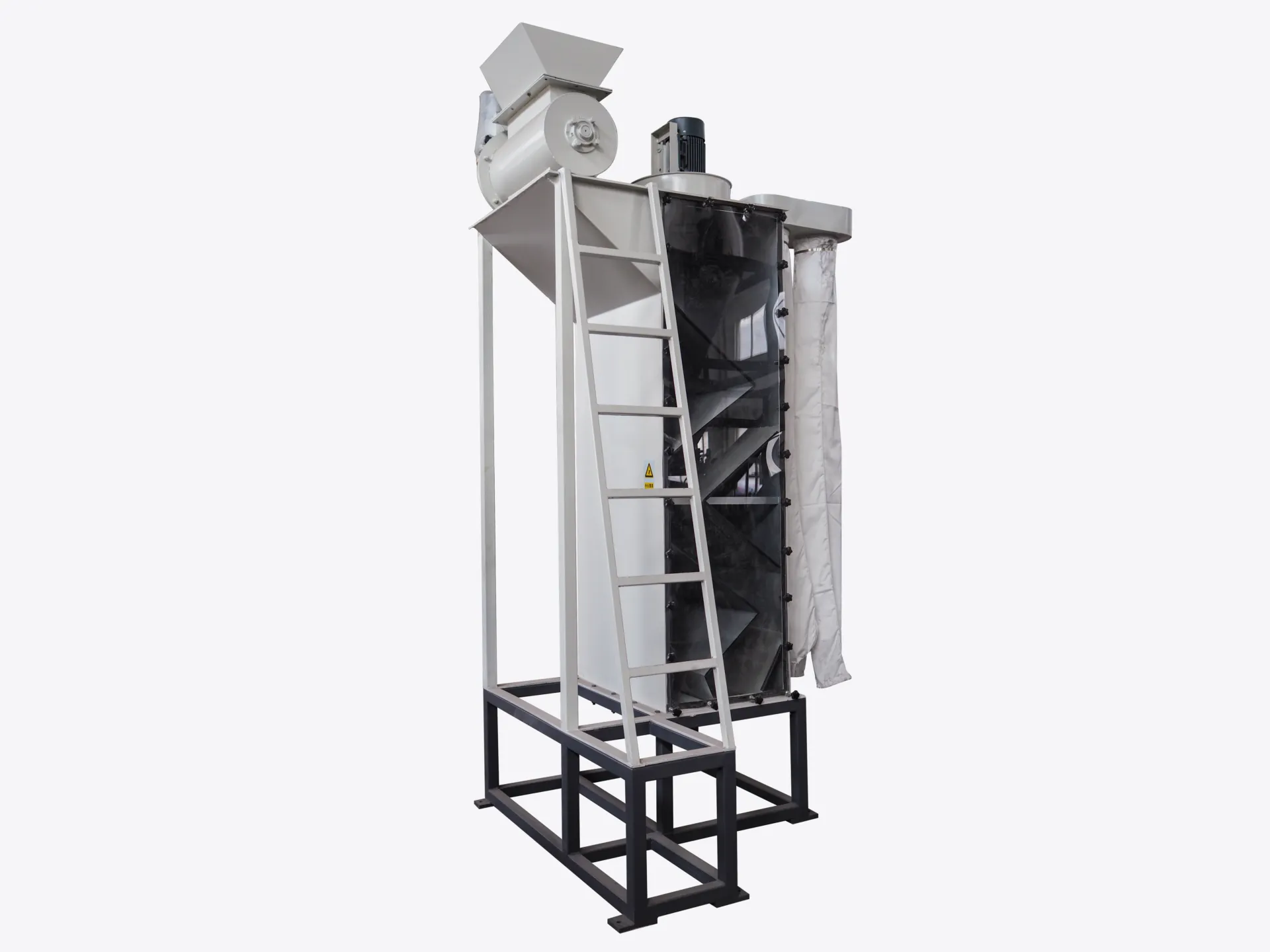En el complejo mundo del reciclaje de plástico, la calidad final del material reciclado es primordial. Lograr esta pureza requiere una serie de sofisticados procesos diseñados para eliminar cualquier rastro de contaminación. Si bien las trituradoras, lavadoras y secadoras suelen ser el centro de atención, un equipo crucial e ingenioso trabaja discretamente en segundo plano: el Clasificador de aire en zigzag, también conocido comúnmente como Separador de etiquetas o Separador de aire en la industria del reciclaje.
Esta máquina es una experta en separación, utilizando un principio simple pero altamente efectivo para purificar escamas de plástico. Este artículo ofrece una introducción detallada sobre qué es, por qué es esencial y cómo contribuye al éxito de una economía circular.
¿Qué es un clasificador de aire Zig-Zag?
Un clasificador de aire en zigzag es un separador mecánico que segrega materiales según su densidad variable y perfiles aerodinámicos. Su nombre distintivo proviene de su componente principal: un canal vertical alto con forma de zigzag. Funciona sin agua, lo que lo convierte en un componente clave de la fase de separación en seco en una línea de reciclaje moderna.
Su principal aplicación en la industria del plástico es eliminar contaminantes ligeros (específicamente etiquetas de papel y película de plástico, así como polvo y partículas finas) de un flujo de escamas de plástico trituradas más pesadas (como PET, HDPE o PP).
El papel fundamental de la separación de etiquetas
Tras recolectar y triturar las botellas de plástico, el material resultante es una mezcla heterogénea. Contiene las valiosas escamas de plástico, pero está muy contaminada con restos de etiquetas, tapones y polvo fino generado durante la trituración.
Si no se eliminan estos contaminantes:
- Comprometen la calidad de los pellets de plástico reciclado finales, lo que provoca decoloración, debilidades estructurales y problemas de procesamiento.
- Pueden arder y degradarse. durante la fase de fusión y extrusión, liberando humos y creando motas negras en el producto final.
- Bajan el valor del mercado del material reciclado, ya que los fabricantes requieren materia prima de alta pureza.
El clasificador de aire Zig-Zag es la defensa de primera línea contra este tipo de contaminación y actúa como una puerta de control de calidad que garantiza que solo los copos limpios pasen a la siguiente etapa.
Cómo funciona: un desglose paso a paso
La genialidad del clasificador de aire en zigzag reside en su elegante uso de la gravedad y el flujo de aire. El proceso se puede dividir en cinco pasos clave:
- Entrada de material: El flujo mixto de escamas de plástico y etiquetas se introduce en una tolva situada en la parte superior de la máquina.
- El efecto cascada: Desde la tolva, el material cae a la cámara en zigzag. Los deflectores angulares hacen que el material se mueva y caiga en cascada de un lado a otro a medida que desciende. Esta acción es crucial, ya que deshace los grumos y garantiza que cada partícula quede expuesta individualmente.
- Flujo de aire a contracorriente: Al mismo tiempo, un potente soplador o ventilador empuja una columna de aire controlada con precisión hacia arriba a través de la cámara, fluyendo contra el material que cae.
- Separación en acción: Aquí es donde ocurre la magia.
- El copos de plástico pesados tienen suficiente masa para superar la presión del aire ascendente y continuar su viaje rodante hasta la salida inferior.
- El contaminantes luminosos (Etiquetas de papel, película plástica, polvo) tienen una gran superficie y baja densidad. Son fácilmente atrapados por la corriente de aire ascendente y se separan del flujo principal de material.
- Doble descarga: La máquina cuenta con dos salidas independientes. Las escamas de plástico pesadas y purificadas se descargan por la parte inferior, listas para el siguiente proceso. Los contaminantes ligeros son transportados por el aire a través de un puerto independiente en el lateral o la parte superior de la máquina, donde se recogen en una bolsa de filtro o un sistema ciclónico para su eliminación.
Componentes clave y características de diseño
Como se ve en el diseño típico, el clasificador consta de varios componentes principales:
- Tolva de alimentación: Donde el material mezclado ingresa al sistema.
- Cámara de separación en zigzag: El corazón de la máquina, diseñado para maximizar el movimiento del material y la exposición al aire.
- Unidad sopladora/ventilador: El motor del proceso, que proporciona el flujo de aire ascendente ajustable.
- Sistema de recolección de contaminantes: Un puerto de salida conectado a un filtro de calcetín grande o ciclón para capturar las fracciones de luz separadas.
- Salida de material limpio: Un embudo en la parte inferior por donde salen los copos purificados.
- Marco de soporte y acceso: Un marco de acero resistente para sostener la estructura vertical, que a menudo incluye una escalera para acceder para mantenimiento.
Conclusión: Un activo indispensable para un reciclaje de calidad
Aunque parezca simple, el clasificador de aire Zig-Zag es un ejemplo de ingeniería brillante. Al aprovechar las fuerzas fundamentales de la gravedad y el aire, realiza una tarea indispensable con alta eficiencia, bajo mantenimiento y mínimo consumo de energía. Es una inversión crucial para cualquier operación de reciclaje seria, ya que contribuye directamente a la producción de plásticos reciclados valiosos y de alta calidad, y fortalece las bases de la economía circular. Es, sin duda, uno de los héroes anónimos del reciclaje moderno.



